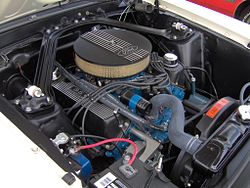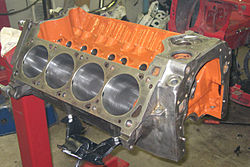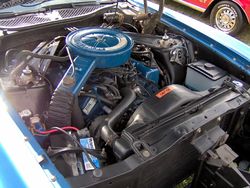- Ford 335 engine
-
Ford 335 V8 Manufacturer Ford Motor Company Also called Ford Cleveland V8 Production 1970–1985 Predecessor Ford FE V8 Successor Ford Windsor V8 Displacement 302 cu in (5 L)
351 cu in (5.8 L)
400 cu in (6.6 L)Cylinder bore 4.0 in (102 mm) Piston stroke 3.0 in (76 mm)
3.5 in (89 mm)
4.0 in (102 mm)Cylinder block alloy Iron Cylinder head alloy Iron Valvetrain OHV The Ford 335 engine family were a group of small-block V8 engines built by the Ford Motor Company between 1970 and 1985. The significance of the Numerals '335' designated to this series of Small block Ford V8 engines is relatively unknown. Conjecture relating to this designation revolves around a prototype 335 CID (Cubic Inch Displacement) engine Ford developed for the Marine industry; to design a V8 motor eliminating the need for water to pass through the inlet manifold and to delete the need for a separate cam timing cover. The series was nicknamed Cleveland after the Cleveland, Ohio engine plant in which most were manufactured. The 335 was used as an option in mid-sized vehicles and trucks concurrently with the larger 351 member of the Windsor small-block family as well as the mid-sized FE V8 family. Although all three of these engine families continued in production the Cleveland, only outliving the FE by a half-decade, was eventually abandoned in favor of the more compact Windsor design.
Contents
Overview
The 335 series, although sharing the same bore spacing and cylinder head bolt pattern, was very different internally from the somewhat similar-looking Windsor series. The 335 Cleveland used smaller 14 mm spark plugs in one of two different cylinder heads, both with 2 valves per cylinder. The '4V' heads had massive ports and valves compared to the '2V'. Both had the valves canted to the sides in a "poly-angle". The '2V' head had a open, almost hemispherical shaped combustion chamber while the '4V' sported a Quench type combustion chamber. The Cleveland has a very square type rocker cover while the Windsor has a more rounded end cover. All 335 covers are secured with 8 bolts, as opposed to 6 on the Windsor.
A differentiation between the Windsor and Cleveland series are the location of the radiator hose — the Windsor routed coolant through the intake manifold, with the hose protruding horizontally, while the Cleveland had a dry manifold with the radiator hose connecting vertically to the cylinder block above the cam timing chain cover.
Inside the block, large main bearing caps are specified for durability, allowing 4-bolt mains on some engines. The 335 oiling system has been widely criticized because of its 'non main priority' schematic; however, for all but the highest level of performance applications, it has not proven any less reliable than the Windsor line.
351 Cleveland
351 Cleveland engines Code Engine type Years Compression Notes H 351C-2V 1970–1974 Low M 351C-4V 1970–1971 High R 351C-4V "Boss 351" 1971 High Rare, solid lifters R 351C-4V HO 1972 Low Very rare, solid lifters, open chamber[1] Q 351C-4V "Cobra-Jet" May 1971-1974 Low , open chamber - See also the Cleveland-derived Boss 351 and quite different 351 "Windsor"
The 351 Cleveland was introduced in 1969 as Ford's new performance car engine and was built through the end of the 1974 model year. It incorporated elements learned on the 385 big-block series and the Boss 302, particularly the poly-angle combustion chambers with canted valves and the thin-wall casting technology.
Both a 4V (4-barrel carburetor) performance version and a 2V (2-barrel carburetor) basic version were built, both with 2 valves per cylinder. The latter had a different cylinder head with smaller valves, smaller ports, and open combustion chambers to suit its intended applications.
Only the Q-code 351 "Cobra Jet" (1971–1974), R-code "Boss" 351 (1971), and R-code 351 "HO" (1972) versions have 4-bolt mains although all 335 series engines (351C/351M/400) have provision for them. The main difference between 351C/351M/400 engines is connecting rod length and main bearing size. The 351M/400 engines have the largest bearing size and the tallest deck height while sharing the 429/460 bell housing pattern. The 351C engine has a medium main bearing size (2.75") and shorter connecting rods (5.78") than the 351W (5.94") and the 351M/400 (6.58") while retaining the SBF (289-302w) engine mount locations and bell housing pattern. The 400 engine has the longest stroke (4.00") of any SBF or 335 series engine.
All of the 351C and 351M/400 engines differ from the 302/351W by having an integrated timing cover casting in the front of the block to which the radiator hose connects.
H-code
The majority of 351 Cleveland engines are H-code 2V (2-venturi carburetor) versions with low compression. They were produced from 1970 through 1974 and were used on a variety of Ford models, from ponycar to fullsize.
M-code
The 351C 4V engines produced in 1970 and 1971 used this code. Engines varied in compression ratio; 1970 engines were 11.0:1 compression and produced 300 bhp (224 kW; 304 PS) at 5400 rpm, while 1971 versions had a slightly lower compression ratio of 10.7:1, and a reduced power output of 285 bhp (213 kW; 289 PS) at 5400 rpm. Ford owner's manuals for these engines recommended high octane gasoline (100+ octane in 1970) which was at the high end of the leaded gasoline available at the time. However, with the mid-1970s introduction of unleaded gasoline and lower octane ratings, and subsequent disappearance of the super high octane leaded fuels required to power these high compression engines, motorists were either unaware of potential damage or simply unable to find this kind of fuel any more. As a consequence, many of these otherwise durable engines met with an early demise due to the destructive effects of severe engine knocking caused by using low octane fuel.
1971 R-code (Boss 351)
The Boss 351 is a high-performance variant available only in the 1971 Boss 351 Mustang. Rated at around 330 hp (246 kW), it was fitted with a four-barrel Autolite spreadbore carburetor, an aluminum intake manifold, and aluminum valve covers. It had four-bolt main block/caps and a premium crankshaft, constructed from high-strength nodular iron. The cylinder head was modified for better airflow and solid lifters. The forged connecting rods were shot-peened and magnafluxed for strength, and used stronger bolts/nuts. Forged domed pistons gave a 11.3:1 nominal (11.1:1 advertised) compression ratio. 1806 Boss 351 Mustangs were produced by Ford in 1971, 591 of which are registered and accounted for on the Boss 351 Registry site. The engine, like most Ford engines, was underrated. In the January 2010 issue of Hot Rod Magazine, they built a Boss 351 to exact specs of an original motor. It produced 383 hp (286 kW) at 6,100 rpm, and 391 lb·ft (530 N·m) torque at 4,000 rpm.[2]
1972 R-code
The R-code 351 Cleveland HO for 1972 was considerably different. The timing was changed to decrease compression for emissions compliance and used open-chamber heads. It had a solid lifter camshaft, however a four barrel carburetor was retained. It produced 275 hp (205 kW) using the new SAE net system.
Q-code (Cobra-Jet)
The Q-code "351 Cobra Jet" version was produced from May 1971 through the 1974 model year. It was a low-compression design that included open-chamber "4V" heads, a special intake manifold, special hi-lift long duration hydraulic camshaft, special valve springs and dampers, a 750 CFM 4300-D Motorcraft Carburetor, dual-point distributor, and 4-bolt main bearing caps. It was rated at 280 bhp (209 kW; 284 PS) for all 1971 applications; 266 hp (198 kW) (SAE net) for 1972 when installed in the Mustang and 248 hp (185 kW) in the Ford Torino and Mercury Montego. The horsepower rating dropped in 1973 to 246 hp (183 kW) for the 4-barrel for the intermediate Fords, and still retained the higher 266 hp (198 kW) rating in the Mustang. The 351 CJ (now referred to simply as the "351 4V") was rated at 255 hp (190 kW) in 1974 and was only installed in the Ford Ranchero, Ford Torino, Mercury Montego and the Mercury Cougar.
302 Cleveland
- Note that there was also a 302 "Windsor"
This engine was built only in Australia from 1972 to 1982, and was intended to give their consumers a smaller capacity alternative to the Geelong built 351 Cleveland, as Ford Australia inherited the patterns, molds and tooling for the 'Cleveland' it was a viable alternative to importing the 302 Windsor. Using a locally reproduced 351 Cleveland block (1972-1985), 302 cu in (4.9 L) was attained by reducing the stroke of the 351C from 3.5 to 3.0 inches (89 to 76 mm) and increasing the connecting rod length from 5.780" to 6.030". Additionally, the 302C cylinder heads were redesigned locally, with smaller combustion chamber(from 72cc to 58cc), to compensate for the reduced stroke of the engine.
The combination of closed combustion chambered quench heads with smaller 2 barrel style ports made a more powerful setup known in the USA as "Australian Cleveland heads". These heads interchange directly onto 351C engines, and are somewhat sought after outside of Australia as a low-cost method to increase compression ratio. They are a good street alternative to the over ported 4 barrel heads. Using the 302C cylinder heads on an otherwise unmodified 351C may increase the compression ratio beyond a safe level for regular pump fuel. Using the small chamber 302C cylinder heads properly requires engine design checks (deck clearance, piston design, camshaft specifications), all optimized for the intended use.
Even though the 302C was not made in Cleveland Ohio, (but in Geelong, Victoria. Australia) the engine has been affectionately referred to as the 302C. Ford engine suffixes are confusing enough, to say the least, so to keep it simple call it what it looks like: a 'Cleveland', as apposed to a 'Geelong'. The last 302C was installed into an Ford XE Falcon Fairmont Ghia ESP Vehicle Identification Number JG32AR33633K in November 1982. Ford Australia contuniued to use the 302 and 351 cleveland in the 4x4 Bronco range and in F-series ambulances until some time in 1985.
400
The big-block FE engine family was getting outdated, and the 385 family could not meet the efficiency requirements of the time. At the same time, the small-block Windsor engines were too small and high-revving for Ford's fullsize car and truck applications. So the company went to work on a new small-block to meet the desired levels of economy while still providing the kind of big-block torque that was needed to move 2+ ton vehicles.
The Ford 400 engine was based on the 351 Cleveland but was produced with a taller deck height of 10.297 inches compared to the 351C's 9.206 inches. This allowed for a longer stroke while retaining the 351C's rod-stroke ratio. These blocks also share the same oiling route in the block. The 400 also featured larger (Windsor sized 3.00 inch with Cleveland cap register) main-bearing journals and had "square" proportions, with a 4.0 in (102 mm) bore and stroke; it therefore displaced 402 cu in (6.6 L), making it the largest small-block V8 made at that time. It was introduced in model year 1971 with a full half-inch (12.7 mm) longer stroke than the 351 Cleveland, making it the longest-stroke Ford pushrod V8 engine. A long-stroke engine has good low-end torque. This was a good compromise given Ford's requirement for an engine to power heavier mid-size and full-size cars and light trucks. The M-block, as it later became known, was the last pushrod V8 block designed by Ford. The M-block also shares some elements with the Windsor engine family: bore spacing, cylinder head bolt-patterns and crankshaft journal dimensions.[3]
The 400 was seen as a smaller and lighter replacement for the big Ford 385 engines, the 429 and 460, in Ford's big cars. Weighing just 80% of a similar big block, it was originally available in Ford's Custom, Galaxie and LTD lines, and in Mercury Monterey, Marquis, and Brougham. Later, it would power the Ford Thunderbird, the Lincoln Continental, Mark V, mid-size Fords and Mercurys, and Ford light-duty trucks.
The vast majority of 400 blocks use the same bellhousing bolt pattern as the 385 family big-block to make it compatible with the higher torque-capacity C6 transmission used on the large cars and trucks. There were a small number of 400 block castings that use dual bellhousing patterns for mounting an FMX transmission. These castings are rare. The 400 was modified in 1975 to use unleaded gasoline.
351 M
Engine dimensions 351M/400 351C Nominal main bearing size 3.000 in (76.2 mm) 2.750 in (69.8 mm) Rod length 6.58 in (167.1 mm) 5.78 in (146.8 mm) Deck height 10.297 in (261.5 mm) 9.206 in (233.8 mm) When the 351 Cleveland was withdrawn after the end of the 1974 model year, Ford needed another engine in the 351 cubic inch (5.8 L) class, since production of the 351 Windsor was not sufficient and the 390 FE was being retired as well. To replace the 390, Ford took the 400 engine's tall-deck block and de-stroked it with the shorter throw crankshaft from the 351 Windsor, and taller pistons, to produce a 351 cubic inch (5.8 L) engine whose components were largely compatible with the 400. This engine was called the 351M and as a back-formation the taller-deck block became known as the M-block.
The M designation is commonly referred to “Modified”, and is derived from the use of both "Cleveland" (block, heads) and "Windsor" (crankshaft) components in the same engine, a modification for the parts' intended application, so to speak.
Another origin of the M designation may have come from where the engine blocks were cast. It follows the naming convention set forth by the 351C (Cleveland) cast at the Cleveland Foundry and 351W (Windsor) where the majority of the blocks were cast at the Windsor Casting Plant. From the introduction in the model year 1975, the 351M engine blocks (which are the same as the 400 engine block) were all produced at the Michigan Casting Center (MCC) in Flat Rock, MI or at the Cleveland Foundry (CF) also known as the Cleveland Casting Plant (CCP). To help distinguish it from the other two different 351s, the logical choice was to use the Michigan Casting Center, hence the “M” designation for 351 Michigan.
The 351 Cleveland had a well known, good reputation in the public. For a few of years after the introduction of the 351M, Ford marketing called the engine the "351 Cleveland". This led to confusion as to what 351 version was actually in the vehicle.
Later, car enthusiasts incorrectly referred to this engine as a "351 Midland" presumably a reference to Midland, Michigan, a city just northwest of Saginaw or reference to an iron foundry in Midland, Texas. But the Ford Motor Company never owned a “Midland” factory.
Light truck usage
For the 1977 model year, Ford decided to replace its aging FE big-block 360 and 390 engines in its light truck line with its new 351M and 400 engines. For light truck use, beefed-up blocks were designed. These enhancements were added to all M-block engines starting with the 1978 model year.
Replacement in cars
The final year the M-block engines were used in cars was 1982. After that, the Ford 351 Windsor at 5.8 L was the only large car engine used. Reduced demand for large engines due to fuel economy regulations led to the abandonment of the Cleveland production line, that produced the 351M and 400 engines, after 1982.
Replacement in trucks
The M-block engine was designed when first-generation pollution controls were already in place. Most Ford V8s required bulky and unsightly external tubing to feed Thermactor air into the exhaust manifolds and exhaust gas to the EGR valve below the carburetor, but this was all built in to the M-block engine.
This all made adapting the M-block to the second generation of emissions control equipment harder. One requirement of the second-generation equipment was an oxygen (O2) sensor in the exhaust, which had to be placed before the Thermactor air was added. Since Thermactor air was injected right into the block's exhaust ports in the M-block, there was nowhere for the O2 sensor to go.
It would have been possible to alter the M-block to work, but it would have required significant effort and cost. Ford decided to simply scrap the M-block engines and replace them with updated 351 Windsor engines at the small end, and a combination of the 6.9 L Navistar International diesel and the 460 at the top end. Sales of the M-block ended in 1982.
See also
References
- ^ Only 398 Ford Mustangs with the 351C HO engine were produced according to production data from Ford
- ^ "Muscle Car Engine Shootout - Ford Boss 351 Vs. Chevy LT-1 350". Hot Rod Magazine. http://www.hotrod.com/techarticles/engine/hrdp_1001_muscle_car_engine_shootout/ford_boss_351_chevy_lt1_350.html.
- ^ "Geoff Infield's Ford V8 page". Archived from the original on 2006-02-18. http://web.archive.org/web/20060218205126/http://www.geocities.com/infieldg/v8main.html. Retrieved July 25, 2006.
External links
Ford Motor Company engine timeline, North American market, 1950s–1970s — Next » Type 1950s 1960s 1970s 0 1 2 3 4 5 6 7 8 9 0 1 2 3 4 5 6 7 8 9 0 1 2 3 4 5 6 7 8 9 Flathead Flathead V8 Small block Y-block V8 351 Cleveland V8 Windsor V8 Medium block V8 Lincoln Y-block 335/Modified V8 Big block MEL V8 FE V8 385 V8 Categories:- Muscle cars
- Ford engines
Wikimedia Foundation. 2010.




